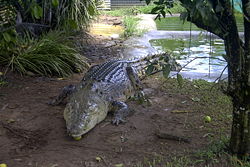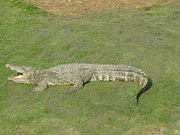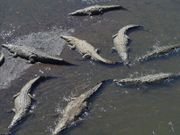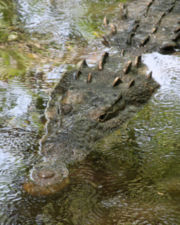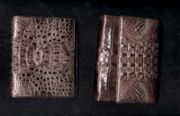Crocodile
2008/9 Schools Wikipedia Selection. Related subjects: Insects, Reptiles and Fish
| Crocodile Fossil range: Late Cretaceous - Recent |
||||||||||
|---|---|---|---|---|---|---|---|---|---|---|
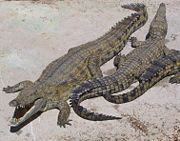 Nile Crocodile
|
||||||||||
| Scientific classification | ||||||||||
|
||||||||||
| Genera | ||||||||||
See full taxonomy. |
A crocodile is any species belonging to the family Crocodylidae (sometimes classified instead as the subfamily Crocodylinae). The term can also be used more loosely to include all members of the order Crocodilia: i.e. the true crocodiles, the alligators and caimans (family Alligatoridae) and the gharials (family Gavialidae), or even the Crocodylomorpha which includes prehistoric crocodile relatives and ancestors. Crocodiles are large aquatic reptiles that live throughout the tropics in Africa, Asia, the Americas and Australia. Crocodiles tend to congregate in freshwater habitats like rivers, lakes, wetlands and sometimes in brackish water. They feed mostly on vertebrates like fish, reptiles, and mammals, sometimes on invertebrates like mollusks and crustaceans, depending on species. They are an ancient lineage, and are believed to have changed little since the time of the dinosaurs. They are believed to be 200 million years old whereas dinosaurs became extinct 65 million years ago; crocodiles survived great extinction events.
Description
- Crocodiles are similar to alligators and caiman; for their common biology and differences between them, see Crocodilia.
Crocodiles are among the more biologically complex reptiles despite their prehistoric look. Unlike other reptiles, they incorporate muscles used for aquatic locomotion into respiration (e.g. M. diaphragmaticus; giving them the functional equivalent of a diaphragm), cerebral cortex and four-chambered heart. Their external morphology on the other hand is a sign of their aquatic and predatory lifestyle. A crocodile’s physical traits allow it to be a successful predator. They have a streamlined body that enables them to swim swiftly. Crocodiles also tuck their feet to their sides while swimming, which makes them faster by decreasing water resistance. They have webbed feet which, although not used to propel the animal through the water, allow it to make fast turns and sudden moves in the water or initiate swimming. Webbed feet are an advantage in shallower water where the animals sometimes move around by walking.
Crocodiles have a palatal flap, a rigid tissue at the back of the mouth that blocks the entry of water. The palate has a special path from the nostril to the glottis that bypasses the mouth. The nostrils are closed during submergence. Like other archosaurs, crocodilians are diapsid, although their post-temporal fenestrae are reduced. The walls of the braincase are bony but they lack supratemporal and postfrontal bones.
Crocodilian scales have pores that are believed to be sensory, analagous to the lateral line in fishes. They are particularly seen on their upper and lower jaws. Another possibility is that they are secretory, as they produce an oily substance that appears to flush mud off.
Crocodiles are very fast over short distances, even out of water. They have extremely powerful jaws capable of biting down with immense force, by far the strongest bite of any animal. The crocodile's bite force is more than 5,000 pounds per square inch, compared to just 335 psi for a rottweiler, 400 psi for a large great white shark, or 800 to 1,000 psi for a hyena. They have sharp teeth for tearing and holding onto flesh, but cannot open their mouth if it is held closed. Since crocodiles feed by grabbing and holding onto their prey, they have evolved powerful muscles that close the jaws and hold them shut. The jaws are opened, however, by a very weak set of muscles. Crocodiles can thus be subdued for study or transport by taping their jaws or holding their jaws shut with large rubber bands cut from automobile inner tubes. All crocodiles have sharp and powerful claws. They have limited lateral movement in their neck, so on land, physical protection can be found by just getting even a small tree between the crocodile's jaws and oneself.
Age
There is no reliable way of measuring crocodile age, although several techniques are used to derive a reasonable guess. The most common method is to measure lamellar growth rings in bones and teeth - each ring corresponds to a change in growth rate which typically occurs once a year between dry and wet seasons. Bearing these inaccuracies in mind, the oldest crocodilians appear to be the largest species. C. porosus is estimated to live around 70 years on average, and there is limited evidence that some individuals may exceed 100 years. One of the oldest crocodiles recorded died in a zoo in Russia. A male freshwater crocodile at the Australia Zoo is estimated to be 130 years old. He was rescued from the wild by Bob Irwin and Steve Irwin after being shot twice by hunters. As a result of the shootings, this crocodile (known affectionately as "Mr. Freshy") has lost his right eye.
Size
Size greatly varies between species, from the dwarf crocodile to the enormous saltwater crocodile. Species of Palaeosuchus and Osteolaemus grow to an adult size of just 1 to 1.5 m. Larger species can reach over 5m (16 ft) long and weigh well over 1200 kg (2,640 lb). Crocodilians show pronounced sexual dimorphism with males growing much larger and more rapidly than females. Despite their large adult size, crocodiles start their life at around 20 cm (8 inches) long. The largest species of crocodile is the saltwater crocodile, found in northern Australia, throughout south-east Asia, and in the surrounding waters.
The largest recorded crocodile is a giant saltwater crocodile measured at 8.6 meters (28.2 feet) and 1352 kg weight (2870 lb) shot in Australia, Queensland in 1957. A "replica" of this crocodile has been made as a tourist attraction. The largest living crocodile known is a 7.1 m (25.3 ft) long saltwater crocodile, in Orissa, India. It lives in Bhitarkanika Wildlife Sanctuary and in June 2006, was entered in the Guinness Book of World Records.
The other two larger certifiable records are both of 6.2 m crocodiles. The first crocodile was shot in the Mary River in the Northern Territory of Australia in 1974 by poachers and measured by wildlife rangers. The second crocodile was killed in 1983 in the Fly River, Papua New Guinea. In this latter crocodile it was actually the skin that was measured by zoologist Jerome Montague, and as skins are known to underestimate the size of the actual animal, it is possible this crocodile was at least another 10 cm longer.
The largest crocodile ever held in captivity is an Estuarine/Siamese hybrid named Yai ( Thai: ใหญ่, meaning big) (born 10 June, 1972) at the famous Samutprakarn Crocodile Farm and Zoo, Thailand. This animal measures 6 m (19 feet) in length and weighs 1,114.27 kg (2,450 lb.).
Another huge captive specimen was a salt water crocodile named Gomek. Gomek was captured by George Craig in Papua New Guinea and sold to St. Augustine Alligator Farm in Florida, USA. Gomek died of heart disease in February 1997. When he died, he was 5.5 m long - as confirmed by St. Augustine Alligator Farm - and probably between 70 and 80 years old.
Yet another enormous crocodile, named Gustave by the Africans who have seen him, is responsible for over 300 human deaths, and allegedly ate an entire hippopotamus. He also stars in a film, titled Primeval. The crocodile's length is said to be anywhere between 20-30 feet long. He lives along the Ruzizi River in Africa.
Wildlife experts, however, argue that the largest crocodile so far found in the Bhitarkanika was almost 25 feet (7.62 m) long, which could be traced from the skull preserved by the Kanika Royal Family. The crocodile was shot near Dhamara in 1926 and later its skull was preserved by the then Kanika King. Crocodile experts estimate the animal at about 7.62 m long since the size of the skull was measured one seventh of the total length of the body.
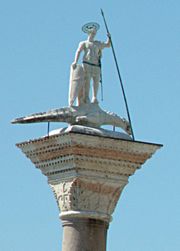
Etymology
The English word crocodile comes from the Ancient Greek κροκόδīλος (krokódīlos) "lizard", used in the phrase ho krokódīlos ho potámios, "the lizard of the [Nile] river" to refer to crocodiles in the current English sense.
There are several variant Greek forms of the word attested, including the later form κροκόδειλος (krokódeilos) found cited in many English reference works . In the Koine Greek of Roman times, krokódīlos and krokódeilos would have been pronounced identically, and either or both may be the source of the Latinized form crocodīlus used by the ancient Romans.
Krokódīlos/krokódeilos itself is described in reference sources as a corruption of krokē ("pebbly"), and drīlos/dreilos supposedly meaning "worm" although attested only as "(man with circumcized) penis" . It is unclear how well supported this analysis is. The meaning of krokē is explained as describing the skin texture of lizards (or crocodiles) in most sources, but is alternately claimed to refer to a supposed habit of (lizards or crocodiles) basking on pebbly ground .
The form crocodrillus is attested in Medieval Latin . It is not clear whether this is a medieval corruption or derives from alternate Greco-Latin forms (late Greek korkodrillos and korkodrillion are attested ).
A (further) corrupted form cocodrille is found in Old French and was borrowed into Middle English as cocodril(le). The Modern English form crocodile was adapted directly from the Classical Latin crocodīlus in the 16th Century, replacing the earlier form.
The use of -y- in the scientific name Crocodylus (and forms derived from it) is a corruption introduced by Laurenti (1768).
Biology and behaviour
Crocodiles are ambush hunters, waiting for fish or land animals to come close, then rushing out to attack. As cold-blooded predators, they are lethargic, therefore survive long periods without food, and rarely need to actively go hunting. Despite their slow appearance, crocodiles are top predators in their environment, and various species have been observed attacking and killing sharks. A famous exception is the Egyptian Plover which is said to enjoy a symbiotic relationship with the crocodile. According to unauthenticated reports, the plover feeds on parasites that infest the crocodile's mouth and the reptile will open its jaws and allow the bird to enter to clean out the mouth (Richford and Mead 2003).
Many large crocodilians swallow stones (called gastroliths or stomach stones) and they are believed to be of use in acting as ballast to balance their body. Other suggestions have been made that they may have a function similar to that of grit in birds, which is in crushing food.
Salt glands are present in the tongues of most crocodylids and they have a pore opening on the surface of the tongue. They appear to be similar to those in marine turtles, however these seem to be absent in Alligatoridae.
Crocodilians can produce sounds during distress and in aggressive displays. They can also hear well and the tympanic membranes are concealed by flat flaps that may be raised or lowered by muscles.
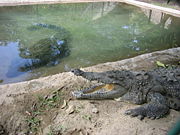
Crocodiles eat fish, birds, mammals and occasionally smaller crocodiles.
Crocodiles are protected in many parts of the world, but they also are farmed commercially. Their hide is tanned and used to make leather goods such as shoes and handbags, whilst crocodile meat is also considered a delicacy. The most commonly farmed species are the Saltwater and Nile crocodiles, while a hybrid of the Saltwater and the rare Siamese crocodile is also bred in Asian farms. Farming has resulted in an increase in the Saltwater crocodile population in Australia, as eggs are usually harvested from the wild, so landowners have an incentive to conserve crocodile habitat.
Crocodiles are more closely related to birds and dinosaurs than to most animals classified as reptiles, the three being included in the group Archosauria ('ruling reptiles'). See Crocodilia for more information.
Crocodile embryos do not have sex chromosomes, and unlike humans sex is not determined genetically. Sex is determined by temperature, with males produced at around 31.6 degrees celsius, and females produced at slightly lower and higher temperatures. The average incubation period is around 80 days, and also is dependent upon temperature.
It has been observed that crocodiles may possess a form of homing instinct. Three rogue saltwater crocodiles were relocated 400 kilometres by helicopter in northern Australia but had returned to their original locations within three weeks, based on data obtained from tracking devices attached to the reptiles.
The land speed record for a crocodile is 17 km/m (11 mph) measured in a galloping Australian freshwater crocodile. Maximum speed varies from species to species. Certain types of crocodiles can indeed gallop, including Cuban crocodiles, New Guinea crocodiles, African dwarf crocodiles and even smaller Nile crocodiles. For most species, the fastest they can move is a kind of "belly run", where the body moves in a snake-like fashion, limbs splayed out to either side paddling away frantically while the tail whips to and fro. Crocodiles can reach speeds of 10 or 11 km/h (around 7 mph) when they "belly run", and often faster if they're slipping down muddy tidal riverbanks. Another form of locomotion is the "high walk" where the body is raised clear off the ground. It is possible for a human to outrun a crocodile; the best way to do so is to run in a straight line rather than zig-zagging back and forth.
Crocodiles do not have sweat glands, so they release heat through their mouths. Consequently, they often sleep with their mouth open and may even pant like a dog.
Danger to humans
The larger species of crocodiles are very dangerous to humans. The main danger that crocodiles pose is not their ability to run after a person but their ability to strike before the person can react. The Saltwater and Nile Crocodiles are the most dangerous, killing hundreds of people each year in parts of south-east Asia and Africa. Mugger crocodiles and possibly the endangered Black Caiman, are also very dangerous to humans. American alligators are less aggressive and rarely assault humans without provocation. The most deaths in a single crocodile attack incident may have occurred during the Battle of Ramree Island, on February 19, 1945, in Burma. Nine hundred soldiers of an Imperial Japanese Army unit, in an attempt to retreat from the Royal Navy and rejoin a larger battalion of the Japanese infantry, crossed through ten miles of mangrove swamps which contained Saltwater Crocodiles. Twenty Japanese soldiers were captured alive by the British, and almost five hundred are known to have escaped Ramree. Many of the remainder may have been eaten by the crocodiles, although gunfire from the British troops was undoubtedly a contributory factor.
Taxonomy of the Crocodylidae
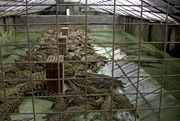
Most species are grouped into the genus Crocodylus. The other extant genus, Osteolaemus, is monotypic (as is Mecistops, if recognized).
- Family Crocodylidae
- Subfamily Mekosuchinae (extinct)
- Subfamily Crocodylinae
- Genus Crocodylus
- Crocodylus acutus , American Crocodile
- Crocodylus cataphractus, Slender-snouted Crocodile (studies in DNA and morphology suggest that this species may be more basal than Crocodylus, and therefore belongs in its own genus, Mecistops)
- Crocodylus intermedius , Orinoco Crocodile
- Crocodylus johnsoni, Freshwater Crocodile
- Crocodylus mindorensis, Philippine Crocodile
- Crocodylus moreletii , Morelet's Crocodile or Mexican Crocodile
- Crocodylus niloticus, Nile Crocodile or African Crocodile (the subspecies found in Madagascar is sometimes called the Black Crocodile)
- Crocodylus novaeguineae, New Guinea Crocodile
- Crocodylus palustris, Mugger Crocodile, Marsh Crocodile, or Indian Crocodile
- Crocodylus porosus , Saltwater Crocodile or Estuarine Crocodile
- Crocodylus rhombifer , Cuban Crocodile
- Crocodylus siamensis, Siamese Crocodile
- Genus Osteolaemus
- Osteolaemus tetraspis, Dwarf Crocodile (there has been controversy whether or not this is actually two species; current thinking is that there is one species with 2 subspecies: O. tetraspis tetraspis & O. t. osborni)
- Genus † Euthecodon
- Genus † Rimasuchus (formerly Crocodylus lloydi)
- Genus † Asiatosuchus
- Genus Crocodylus
Some of the extinct relatives of true crocodiles, members of the larger group Crocodylomorpha, were herbivorous.
Crocodile products
Crocodile leather can be made into goods such as wallets, briefcases, purses, handbags, belts, hats, and shoes.
Crocodile is consumed in some countries, such as Australia, Ethiopia, Thailand, South Africa and also Cuba (in pickled form); it can also be found in specialty restaurants in some parts of the United States. The meat is white and its nutritional composition compares favourably with that of other meats. It tends to have a slightly higher cholesterol level than other meats. Crocodile meat has a delicate flavour; some describe it as a cross between chicken and crab. Crocodile meat can be complemented by the use of marinades. Cuts of meat include backstrap and tail fillet.
Crocodile oil has been used for centuries as a natural healing skin balm.

